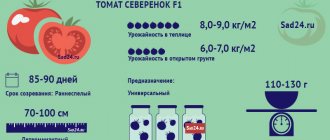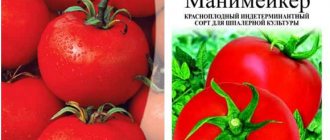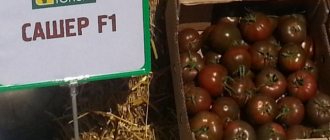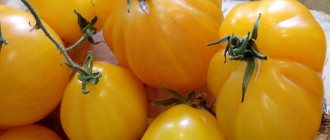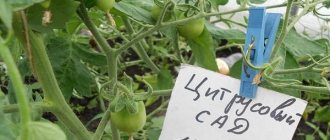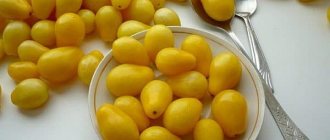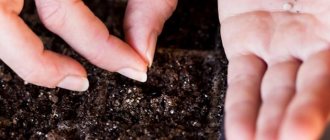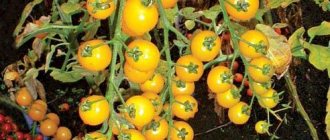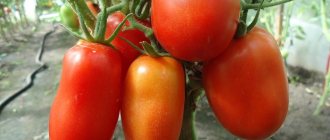Description of tomato Lark
The tomato variety Zhavoronok F1 is a first-generation hybrid, which was bred by breeders of the Transnistrian Research Institute of Agriculture. Its distribution is carried out by the seed industry. The variety has not yet been included in the State Register of Breeding Achievements of the Russian Federation, but thanks to good reviews it is being actively distributed by gardeners for cultivation in summer cottages.
The hybrid tomato variety Zhavoronok F1 has a determinate bush type. After the ovary of four clusters, the growth of the main stem stops, and the next part of the crop begins its formation on the stepsons of the bush.
Considering that the Zhavoronok variety is classified as determinant, the plant is quite large in size: in comfortable growing conditions it can reach from 70 cm to 90 cm in height.
The flower brush is simple, can set up to 6 fruits; begins its formation after the appearance of 5 true leaves. The growth of the next 2 - 3 brushes occurs every 2 leaves.
The tomato variety Zhavoronok F1 belongs to the ultra-early ripening tomatoes: the first ripened fruits on the bush will be visible already on the 80th day from the moment of emergence. By planting ready-made seedlings in the soil in early June, you can harvest more than a dozen tomatoes already in the middle of the next month.
Description of fruits
The fruits of the Zhavoronok variety ripen almost simultaneously, which makes harvesting much easier. They are not prone to cracking and fully retain their qualities during transportation over long distances.
Ripe fruits of Zhavoronok tomatoes have an oval shape and a dense glossy surface. The average weight of one tomato is 100 - 120 g. Tomatoes of this variety are characterized by a rich red color and the absence of an unripe green spot on the surface of the stalk.
Tomato variety Zhavoronok is fleshy in cross-section, with a dense structure and juicy pulp. It contains up to 3.5% sugar and 6.5% solids, which gives excellent taste.
Tomatoes of the Zhavoronok variety are widely used in the preparation of salads, juices, tomato paste, sauces, lecho, and are also successfully used for preservation.
Why should you choose this hybrid?
Breeders have long realized that hybrids are much more resistant to weather conditions and temperature changes than their non-hybrid brothers. Therefore, when creating a particular hybrid, the best qualities for the tomato are selected. Hybrid Lark boasts the following qualities:
- its yield is significantly higher than early-ripening non-hybrid varieties, it exceeds them by 1.5-2 times;
- due to the presence of heterosis, the Lark is less prone to diseases and pest attacks;
- the fruits of the Zhavoronok tomato ripen evenly, which allows you to plan harvesting and further use;
- The hybrid is well transported and can be stored for a long time when ripe.
Note! Vegetable hybrids do not belong to genetically modified products, since they do not have genes unusual for this type of vegetable.
Main characteristics
The tomato variety Zhavoronok F1 is grown both in open soil and in greenhouses. Climatic conditions play an important role in sowing: in regions with a warm climate, seeds can be sown directly in open ground, and in cold conditions it is better to grow tomatoes through seedlings.
In open ground, the tomato variety Zhavoronok has an average yield level: 6 - 8 kg per 1 m², and in a greenhouse - 12 - 14. The largest amount of yield of this variety is produced by pre-grown seedlings from seeds. When planting in the ground, it is important to observe crop rotation: recommended predecessors: onions, cabbage, carrots, cucumbers - plants with a shallow root system.
Advantages and disadvantages
Growing a hybrid variety of tomatoes, Lark, has many advantages. These include:
- High level of crop productivity;
- Resistance to late blight and other nightshade diseases - due to the effect of heterosis of first-generation hybrids, which gives increased vitality;
- Simultaneous ripening of fruits;
- The ability to grow shrubs in almost any climatic zones and conditions;
- Long shelf life of tomatoes, adaptability of fruits for transportation.
It is worth noting the unique taste and aroma of the Zhavoronok tomato variety, which differ significantly from ordinary varietal tomatoes.
The conditional disadvantages of the variety include the need to tie the bush to the base.
Features of cultivation
The seedlings are planted in the traditional way for early-ripening tomatoes. Planting time is calculated approximately 60 days before planting in open ground. Experts recommend placing no more than five plants on an area of one square meter. This is explained by the fact that the Lark bushes have a very spreading structure.
In the future, daily care of the Lark tomato consists of:
- abundant but reasonable watering;
- feeding with complex mineral fertilizers;
- preventive protective measures.
Important! Using the seedless method, the Lark tomato grows only in the southern regions. In any other area, growing seedlings is required.
Rules for planting and care
Like any crop, the Zhavoronok tomato variety has its own characteristics of sowing and growing, which should be taken into account when caring for the plant. To obtain the maximum yield, it is necessary to follow the rules of agricultural technology.
Sowing seeds for seedlings
The seeds of the Lark hybrid can be sown without preliminary preparation, however, in this case, the risk of pathogens of various diseases entering the soil increases several times: seedlings of unawakened seeds appear much more slowly, and the lack of biostimulants can significantly weaken the sprouts. Therefore, it is important to adhere to these rules:
- Only the largest tomato seeds, with the correct shape and without damage, should be selected for sowing;
- Before sowing, the seeds are treated: in a solution of Fitosporin for 2 hours; in a 1% solution of potassium permanganate – 20 minutes; in hydrogen peroxide (heated to 40 oC) – 5 minutes. This is necessary in order to neutralize pathogens of fungal and bacterial diseases spreading through seeds and soil.
Important!
Seeds pickled in potassium permanganate and peroxide require additional washing. It is recommended to use melt water for irrigation: it has a different structure and has a beneficial effect on seed growth.
Sprouted tomato seeds germinate much faster, in addition, they can be sown immediately in separate containers without subsequent picking, which slows down the growth of seedlings.
Before sowing seeds of the Zhavoronok variety for seedlings, you must:
- Stock up on containers for sowing in advance. Plastic containers, wooden crates and cut-off milk cartons work well for this.
- You should also prepare the soil for sowing in advance; it is best to do this in the fall. A few days before planting the seeds, it should be placed in a warm room.
- Make a composition of soil, peat, humus (or compost) in a ratio of 1:2:1:0.5, respectively. Another option is to purchase a universal substrate at a specialty store.
- By soaking the seeds for 10-12 hours in advance, you can significantly speed up the process of growing seedlings. It is recommended to use a growth stimulator (Zircon, Epin, Immunocytophyte): this will help activate the plant immunity.
Seed sowing algorithm:
- Pour a loose layer of soil into a pre-prepared container.
- Place the seeds 1 cm apart.
- Cover with a 1.5 cm layer of soil mixture.
- Place containers with seeds in a warm place with sufficient access to light for at least 12 hours a day: you can arrange illumination with a phytolamp.
What you need to care for seedlings:
- In the first seven days after the sprouts appear, the room temperature should not be higher than 16 degrees during the day and 14 degrees at night;
- For irrigation, use water at room temperature;
- When the soil surface begins to dry out, it is necessary to irrigate the soil;
- Feeding seedlings of the Zhavoronok variety consists of mineral fertilizers with a full range of micro- and macroelements. It is carried out twice: in the formation phase of the first two true leaves and two weeks later;
- Before moving the seedlings into the soil, they are hardened: two weeks before being placed in open ground, the plants are periodically taken out onto a loggia or balcony, gradually increasing the weathering time.
Transplanting seedlings
Tomatoes are transplanted after the first true leaves appear, 6 - 7 days after germination. However, some gardeners advise waiting a few more days to allow the stem to strengthen and the root system to thicken (on the 12th - 14th day).
It is also necessary to properly prepare the soil for replanting: to do this, mix peat, rotted compost and sand in equal parts. To increase soil fertility, you should add a pinch of superphosphate and potassium sulfate, as well as a little vermicompost, which can be purchased at a specialty store. A good effect is achieved by using hydrogel - this is a polymer crumb that absorbs moisture when watering, and then releases it back after a while. By adding a little hydrogel to the root system when transplanting seedlings, you don’t have to worry about stagnation of water in the soil or its drying out.
A couple of days before transplanting, the seedlings need to be watered: then the dry soil will remain on the roots, which will significantly shorten the period of establishment of the plant. To carefully remove a plant from a common container, it is best to use a toothpick or a small knife: this will make it easier for the bushes to be separated from the ground. It is best to keep the plant close to the root lobe so as not to damage its green part.
You need to make a hole in the soil: place a pencil in the ground and make several circular movements, gradually increasing the diameter of the circle in the ground. Place the seedling in the hole and pour some water. Then the flow of water will better straighten the roots of the plant and “attach” it to the ground.
Tomato seedlings Lark should be planted at a distance of 60 - 70 cm between rows and 30 - 40 cm between plants. You should not place bushes close to each other: lack of space for plant development can provoke the occurrence of diseases.
Seedlings should be placed in soil with a temperature of up to 15 oC. The most optimal time for this will be the first ten days of June. So, sowing of seeds takes place in early April, and when the seedlings grow within 45 - 50 days, transplantation will take place in the second half of May.
How to grow tomatoes
Growing tomatoes of the Mazarin variety occurs by analogy for a greenhouse and open ground.
Landing
Seedlings are planted in open ground immediately after the end of night frosts. The soil is warming up to 18 degrees. This happens only at the end of May or in June, which depends on the climatic characteristics of the region.
The seedling planting scheme requires compliance with the parameters of 3 pieces per 1 sq.m. It is not recommended to place the sprouts close, otherwise the yield can be reduced. Before planting, holes are made, and a tablespoon of mixed pre-feeding is placed in them - potassium and phosphorus salts are mixed in equal parts.
Care
Immediately after planting the seedlings in the holes, they are buried and watered. Next, adhere to the following care rules:
- Water the tomatoes as the soil dries. In summer and when growing in open ground, this happens daily. But if the tops grow and have a bright green tint, but there are no flowers, it means that watering is reduced. Everything is explained by excess moisture. You can reduce not the frequency of watering, but the volume of water.
- Weeding of the beds is also carried out as needed.
- Loosening is best done after each watering - this improves air circulation in the soil. It is mandatory to loosen the soil after each weeding.
- Stepchildren are removed every time they arise. It is enough to leave the central stem and 5-6 full clusters on it. This way you get a neat bush.
- The bush must be tied up as it grows. If it grows upward and there are few side branches, it is better to pinch the top. This increases the chances of side shoots forming. They are allowed to grow until clusters form. This problem is often caused by low lighting.
- Once a month it is recommended to feed tomatoes with phosphorus fertilizer.
If all the rules are followed, there will be no difficulties in growing Mazarin tomatoes. Prevention should be carried out periodically - inspect the bushes for the presence of pests and diseases, and also remove dried leaves.
Tomato care
To create the best conditions for growing the Zhavoronok tomato variety, it is important to provide the plant with an open, well-lit place to grow, proper watering and timely mulching of the soil.
It is best to water the Lark variety in the morning, preferably with warm water. Watering should be done every week during the period of active growth and until fruit set. After this, the frequency of watering increases to two weeks, taking into account the likelihood of precipitation.
Tomatoes need to be fed 3-4 times per season. Mineral fertilizers, which can be purchased in specialized stores, have a beneficial effect on the growth of the Zhavoronok variety.
If shoots develop at the bottom of the first flower cluster, pinching should be done.
Important! Tomato variety Zhavoronok is not suitable for cultivation in the northern regions: the cold climate significantly slows down the period of fruit ripening.
One of the main advantages of the Zhavoronok variety is its high level of disease resistance, but despite this, the plant requires regular preventive maintenance.
Spraying a tomato with a garlic or nut solution, which is carried out during the development of stepsons, will help protect the bush from late blight.
Preparing the solution is quite simple: crushed nuts or garlic cloves are soaked in water overnight and then filtered through a sieve. Spraying should be done once every two weeks.
By spraying the bush with a weakly concentrated solution of boric acid, you can protect the tomato from garden pests and also reduce the risk of developing late blight.
The liquid from yeast dissolved in water helps to degrease the plant, and also stimulates its growth and productivity, and the iodine solution will protect the tomato from garden pests.
If the Zhavoronok variety is infected with late blight, the bush should be treated with diluted kefir or whey.
You can find out more information about growing and caring for tomatoes in the video:
Nuances of crop rotation
Under no circumstances should you plant tomatoes, and especially early Lark, in beds where cabbage, carrots or beans previously grew. You should not do this if the bed was occupied by other nightshade crops last season.
Advice! If you have a small plot, following the rules of crop rotation is quite problematic. The solution to the problem could be this: at the end of the harvest, sow some green manure in this place, dig up the soil for the winter and feel free to plant the Lark.
Green manures are commonly called green fertilizers; they can be used all year round in the intervals between planting main vegetables. The most common green manure plants are: oats, lupine, mouse peas, rapeseed, rye, mustard and phacelia.
The choice of green manure is determined by the lack of soil microelements:
- nitrogen fertilizers are replaced by clover;
- the lack of phosphorus is successfully compensated by lupine;
- Oat rye suppresses the growth of weeds quite strongly.
